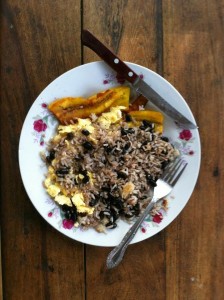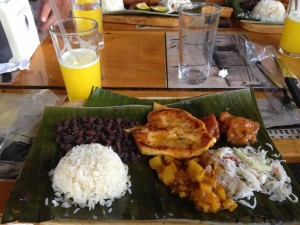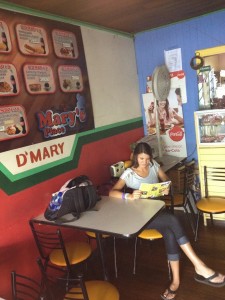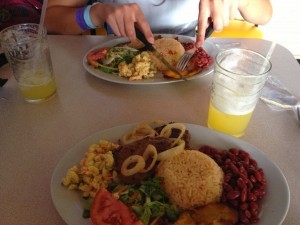What better way to immerse yourself in another culture than by eating the local delicacies? Food is indeed a part of culture and I can proudly say that I have been experiencing and enjoying that aspect for the past six weeks.
I have found that Costa Rican food isn’t drastically different than in the United States. My friends and I agree that it is a bit carb heavy but the fruits and vegetables are so fresh and the portions aren’t as excessive as what we are used to in the States. I am going to introduce you to two traditional Costa Rican dishes that I have fallen in love with and can’t wait to make for my friends and family when I go home: gallo pinto and the casado.
Gallo Pinto
A literal translation of gallo pinto is spotted rooster, but no need to worry I have not been indulging in any spotted roosters here. Gallo pinto is actually just white rice and black beans! So what is so special about rice and beans?
Well, since the moment I got off the plane I have been eating rice and beans almost every day; it's a staple in the Costa Rican diet. In many parts of the world rice and beans are consumed by lower income families because they very inexpensive and can feed a lot of people; however, in Costa Rica everyone eats it. Rich or poor, you most likely eat rice and beans at least once a day. Oftentimes gallo pinto is eaten at breakfast with toast or a tortilla and eggs. There are also different variations; some Ticos add cilantro or red pepper to theirs and on the Caribbean side it is common to add coconut.

Casado/Comida Típica (Typical Food)
Casado, meaning “married man”, is an accompaniment of all things delicious in Costa Rica on one plate. They are always served at sodas (local mom and pop restaurants) and more upscale versions can be found at higher-end establishments. The casado was the first Costa Rican dish I had when I came off the plane, and it was a perfect introduction for my pallet to the food I would be enjoying for the next three months.
There are several elements to the casado: rice and beans (of course), a protein (chicken, steak with grilled onions, fish, or pork), salad, plantains, and a natural drink (fresco). You can find many variations of these elements, which oftentimes change daily at most sodas.

The crowd favorite at Veritas (the university we are studying at) has been Mary’s Place, located two blocks away from campus. She offers “casaditos” which are a “smaller” version of the casado for only 2 mil colones ($4). Mary is so warm and welcoming to all of the American students and her prices just cannot be beat. The service is a little slow due to the fact that the staff usually includes just Mary and one other person, but it is always worth it when she brings out this incredible plate of local food and an ice cold natural drink.



I cannot wait to introduce my friends and families to the world of frescos when I return home from studying abroad. They will be ditching their Crystal Light packets in no time and start blending up their own frescos. Unfortunately some of these fruits aren’t widely available in the United States nor as fresh, but when I make my own back home it will definitely bring back memories of Costa Rica with every sip.
¡Pura Vida!
Emily Franks is the Fall 2013 CEA MOJO in San José, Costa Rica. She is currently a junior at DePaul University.
I have found that Costa Rican food isn’t drastically different than in the United States. My friends and I agree that it is a bit carb heavy but the fruits and vegetables are so fresh and the portions aren’t as excessive as what we are used to in the States. I am going to introduce you to two traditional Costa Rican dishes that I have fallen in love with and can’t wait to make for my friends and family when I go home: gallo pinto and the casado.
Gallo Pinto
A literal translation of gallo pinto is spotted rooster, but no need to worry I have not been indulging in any spotted roosters here. Gallo pinto is actually just white rice and black beans! So what is so special about rice and beans?
Well, since the moment I got off the plane I have been eating rice and beans almost every day; it's a staple in the Costa Rican diet. In many parts of the world rice and beans are consumed by lower income families because they very inexpensive and can feed a lot of people; however, in Costa Rica everyone eats it. Rich or poor, you most likely eat rice and beans at least once a day. Oftentimes gallo pinto is eaten at breakfast with toast or a tortilla and eggs. There are also different variations; some Ticos add cilantro or red pepper to theirs and on the Caribbean side it is common to add coconut.

Casado/Comida Típica (Typical Food)
Casado, meaning “married man”, is an accompaniment of all things delicious in Costa Rica on one plate. They are always served at sodas (local mom and pop restaurants) and more upscale versions can be found at higher-end establishments. The casado was the first Costa Rican dish I had when I came off the plane, and it was a perfect introduction for my pallet to the food I would be enjoying for the next three months.
There are several elements to the casado: rice and beans (of course), a protein (chicken, steak with grilled onions, fish, or pork), salad, plantains, and a natural drink (fresco). You can find many variations of these elements, which oftentimes change daily at most sodas.

The crowd favorite at Veritas (the university we are studying at) has been Mary’s Place, located two blocks away from campus. She offers “casaditos” which are a “smaller” version of the casado for only 2 mil colones ($4). Mary is so warm and welcoming to all of the American students and her prices just cannot be beat. The service is a little slow due to the fact that the staff usually includes just Mary and one other person, but it is always worth it when she brings out this incredible plate of local food and an ice cold natural drink.


I have really enjoyed the natural drinks since I have been in Costa Rica. They are served at practically every restaurant and my “mama tica” makes a pretty mean piña fresco (pineapple). A fresco is made by blending or juicing one or more types of fruit and adding water or milk and some sugar. Here is a list of the different flavors I have tried since my time here.
- Carambola (star fruit)
- Cas (a fruit native to only Costa Rica, sour guava)
- Guanabana (soursap)
- Mango
- Mora (blackberry)
- Naranja (Orange)
- Sandia (watermelon)
- Piña (pineapple)
- Tamarindo (Tamarind
- Fresa (strawberry)
- Frutas Mixtas (mixed fruit)

I cannot wait to introduce my friends and families to the world of frescos when I return home from studying abroad. They will be ditching their Crystal Light packets in no time and start blending up their own frescos. Unfortunately some of these fruits aren’t widely available in the United States nor as fresh, but when I make my own back home it will definitely bring back memories of Costa Rica with every sip.
¡Pura Vida!
Emily Franks is the Fall 2013 CEA MOJO in San José, Costa Rica. She is currently a junior at DePaul University.









